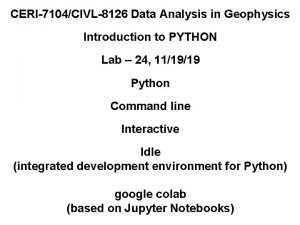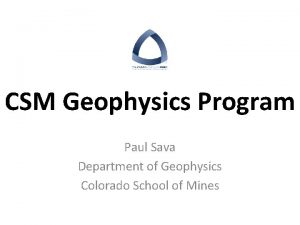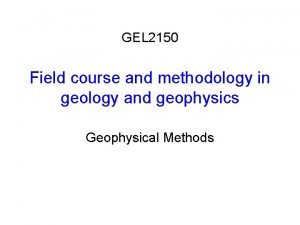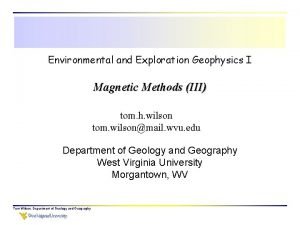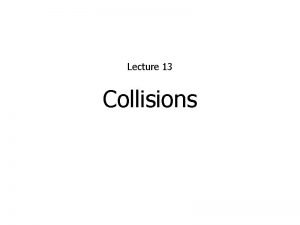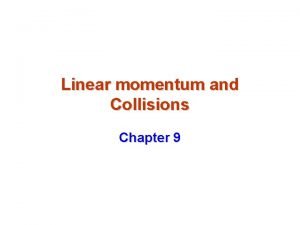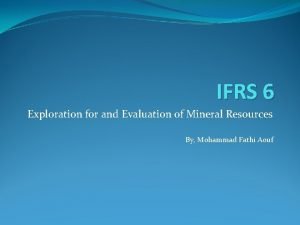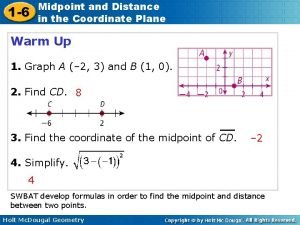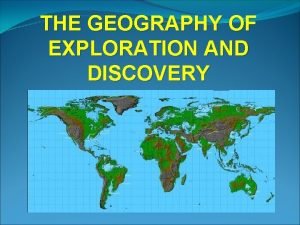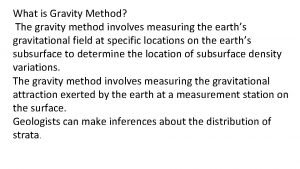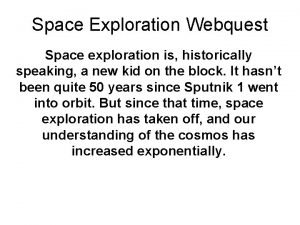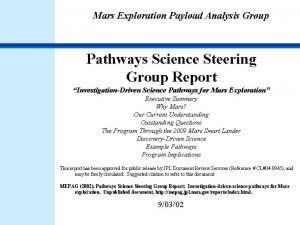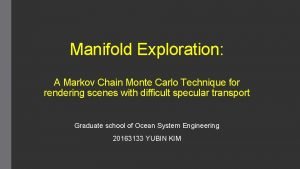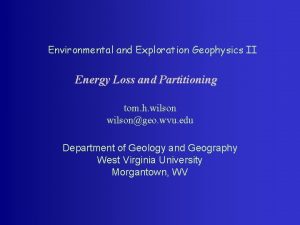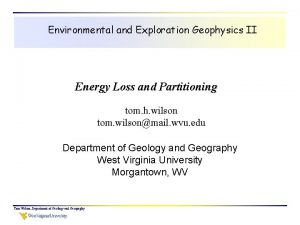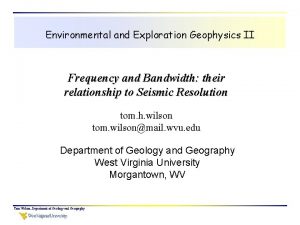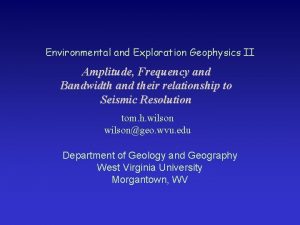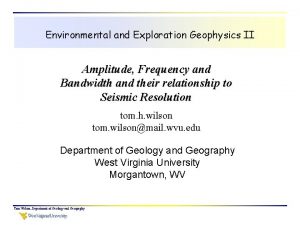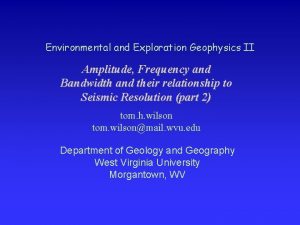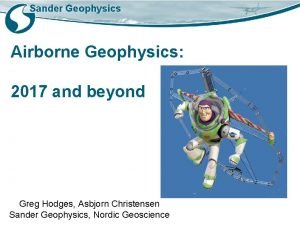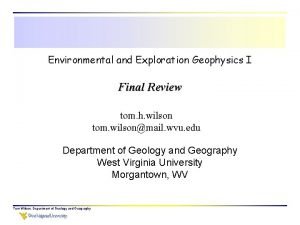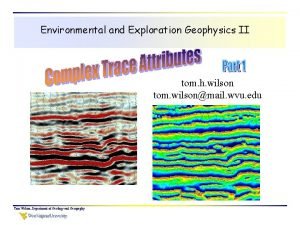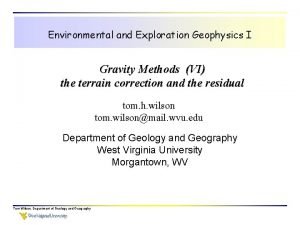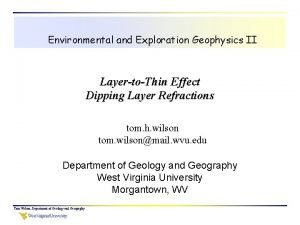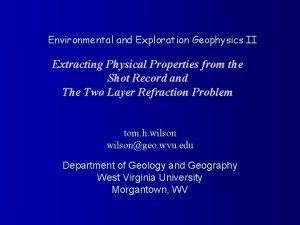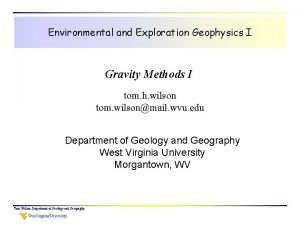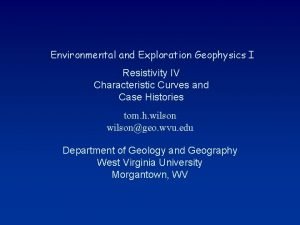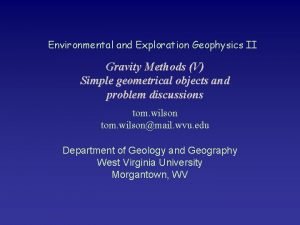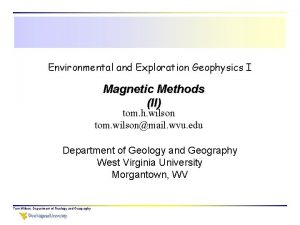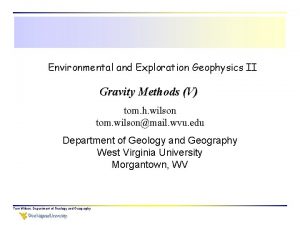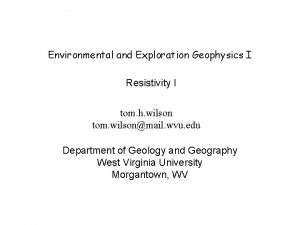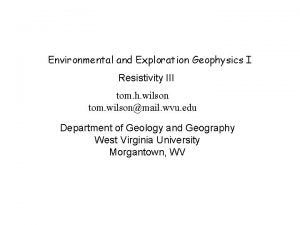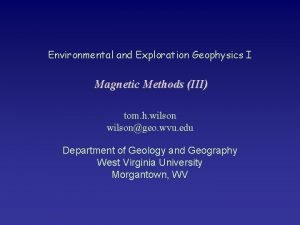Environmental and Exploration Geophysics II Energy Loss and



















































- Slides: 51

Environmental and Exploration Geophysics II Energy Loss and Partitioning tom. h. wilson tom. wilson@mail. wvu. edu Department of Geology and Geography West Virginia University Morgantown, WV Tom Wilson, Department of Geology and Geography

Objectives for the day • Review time-distance plots • Discuss energy loss through divergence and absorption mechanisms • Present basic definition of reflection coefficient and how it varies with offset or incidence angle • Basic definition of transmission coefficient Tom Wilson, Department of Geology and Geography

Can you name the events? Miller et al. 1995 Tom Wilson, Department of Geology and Geography

Ground roll = noise to the exploration geophysicist Tom Wilson, Department of Geology and Geography

We start off with these noisy looking field records and with some effort get a more geological look at the subsurface Tom Wilson, Department of Geology and Geography

Diffraction (point source) Events Tom Wilson, Department of Geology and Geography

Diffractions, like reflections are hyperbolic in a time-distance plot. They are usually symmetrical about the apex. Diffractions usually arise from point-like discontinuities and edges ( for example the truncated edges of stratigraphic horizons across a fault). Tom Wilson, Department of Geology and Geography

Note that the apex of the diffraction event is not located at the source location (X=0). The apex is located over the discontinuity. Tom Wilson, Department of Geology and Geography

A direct path oint p e ag m i e et h g t u e Us lp yo mes e h ti to n o i t c refle How do you figure out Xmin & tmin for the critical refraction? What is the critical refraction time at longer offsets? Tom Wilson, Department of Geology and Geography

1) label all plotted curves, 2) label all relevant points and 3) Describe the relationships that you’ve graphed. Tom Wilson, Department of Geology and Geography

What to you think the influence of higher velocity will be on the moveout? r o f e t 0 es? h t as ’s t c a Wh e two s the • Do Exercise II and III using Excel. • In exercise II comment on the origins of the differences in the two reflection hyperbola? What is their relationship to corresponding direct arrivals. Tom Wilson, Department of Geology and Geography

Although the time intercept remains the same - how do the shapes of the reflection hyperbola differ in these two cases? Tom Wilson, Department of Geology and Geography

ay w r th u a o p y ch k r Wo ng ea alo For Exercise III, explain the differences observed in the arrival times of the reflection and diffraction observed in the shot record. Why does the diffraction event drop below the reflection? Tom Wilson, Department of Geology and Geography

Your plots should be consistent with expected relationships discussed in class Tom Wilson, Department of Geology and Geography

Tom Wilson, Department of Geology and Geography

Tom Wilson, Department of Geology and Geography

First arrival picks and velocity 170 feet offset • Can you pick out the direct arrival? • Can you pick out the refraction arrivals? • How many critical refractions are there? • How would you determine the refraction velocity? • How would you determine the air wave or direct arrival velocity? Tom Wilson, Department of Geology and Geography 0. 15 seconds

Velocities > VA, VB VC, Vairwave VA= VC= VB= Tom Wilson, Department of Geology and Geography

Section 2. 3 What happens to the seismic energy generated by the source as it propagates through the subsurface? Basic Concepts. Energy - The ability to do work. It comes in two forms - potential and kinetic Work expended (W) equals the applied force times the distance over which an object is moved. Power is the rate at which work is performed. As a mechanical disturbance or wavefield propagates through the subsurface it moves tiny particles back and forth along it path. Particle displacements are continually changing. Hence, it is more appropriate for us to consider the power, or the rate at which energy is being consumed at any one point along the propagating wavefront. Tom Wilson, Department of Geology and Geography

The rate of change of work in unit time. This force is the force exerted by the seismic wave at specific points along the propagating wavefront. Tom Wilson, Department of Geology and Geography

and since force is pressure (p) x area (A), we have The power generated by the source is PS. This power is distributed over the total area of the wavefront A so that We are more interested to find out what is going on in a local or small part of the wavefield. * Note we are trying to quantify the effect of wavefront spreading at this point and are ignoring heat losses. Tom Wilson, Department of Geology and Geography

Over what surface area is the energy generated by the source distributed? Tom Wilson, Department of Geology and Geography

Area of a hemisphere is 2 R 2 hence - This is the power per unit area being dissipated along the wavefront at a distance R from the source. (Recall p is pressure, v is the particle velocity, PS magnitude of the pressure disturbance generated at the source and R is the radius of the wavefront at any given time. Tom Wilson, Department of Geology and Geography

In the acoustic wave equation a quantity Z which is called the acoustic impedance. Z = V, where is the density of the medium and V is the interval velocity or velocity of the seismic wave in that medium. Z is a fundamental quantity that describes reflective properties of the medium. We also find that the pressure exerted at a point along the wavefront equals Zv or Vv, where v is the particle velocity - the velocity that individual particles in the disturbed medium move back and forth about their equilibrium position. Tom Wilson, Department of Geology and Geography

Particle velocity versus interval velocity Tom Wilson, Department of Geology and Geography

Combining some of these ideas, we find that v, the particle displacements vary inversely with the distance traveled by the wavefield R. Tom Wilson, Department of Geology and Geography

• We are interested in the particle velocity variation with distance since the response of the geophone is proportional to particle (or in this case) ground displacement. So we have basically characterized how the geophone response will vary as a function of distance from the source. • The energy created by the source is distributed over an ever expanding wavefront, so that the amount of energy available at any one point continually decreases with distance traveled. • This effect is referred to as spherical divergence. But in fact, the divergence is geometrical rather than spherical since the wavefront will be refracted along its path and its overall geometry at great distances will not be spherical in shape. Tom Wilson, Department of Geology and Geography

The effect can differ with wave type. For example, a refracted wave will be confined largely to a cylindrical volume as the energy spreads out in all directions along the interface between two intervals. z R The surface area along the leading edge of the wavefront is just 2 R z. Tom Wilson, Department of Geology and Geography

Hence (see earlier discussion for the hemisphere) the rate at which source energy is being expended (power) per unit area on the wavefront is Remember Zv 2 is just Following similar lines of reasoning as before, we see that particle velocity Tom Wilson, Department of Geology and Geography

The dissipation of energy in the wavefront decreases much less rapidly with distance traveled than does the hemispherical wavefront. This effect is relevant to the propagation of waves in coal seams and other relatively low-velocity intervals where the waves are trapped or confined. This effect also helps answer the question of why whales are able to communicate over such large distances using trapped waves in the ocean SOFAR channel. Visit http: //www. beyonddiscovery. org/content/view. page. asp? I=224 for some info on the SOFAR channel. Tom Wilson, Department of Geology and Geography

Sound Surveillance System See also - http: //www. beyonddiscovery. org/Includes/Dialogs/External. Link. asp? ID=3101&URL= Tom Wilson, Department of Geology and Geography

Divergence losses decrease particle velocity or the amplitude of a seismic wave recorded by the geophone - i. e. the amplitude of one of the wiggles observed in our seismic records. Unless we correct for this effect – turn up the volume – the signal will become too weak for us to hear. Tom Wilson, Department of Geology and Geography

Since amplitude (geophone response) is proportional to the square root of the pressure, we can rewrite our divergence expression as Thus the amplitude at distance r from the source (Ar) equals the amplitude at the source (AS) divided by the distance traveled (r). This is not the only process that acts to decrease the amplitude of the seismic wave. Tom Wilson, Department of Geology and Geography

Absorption When we set a spring in motion, the spring oscillations gradually diminish over time and the weight will cease to move. In the same manner, we expect that as s seismic wave propagates through the subsurface, energy will be consumed through the process of friction and there will be conversion of mechanical energy to heat energy. We guess the following - there will be a certain loss of amplitude d. A as the wave travels a distance dr and that loss will be proportional to the initial amplitude A. i. e. How many of you remember how to solve such an equation? Tom Wilson, Department of Geology and Geography

is a constant referred to as the attenuation factor In order to solve for A as a function of distance traveled (r) we will have to integrate this expression In the following discussion, let Tom Wilson, Department of Geology and Geography

Tom Wilson, Department of Geology and Geography

Mathematical Relationship Graphical Representation Tom Wilson, Department of Geology and Geography

- the attenuation factor is also a function of additional terms is wavelength, and Q is the absorption constant 1/Q is the amount of energy dissipated in one wavelength ( ) - that is the amount of mechanical energy lost to friction or heat. Tom Wilson, Department of Geology and Geography

is also a function of interval velocity, period and frequency Tom Wilson, Department of Geology and Geography

is just the reciprocal of the frequency so we can also write this relationship as Tom Wilson, Department of Geology and Geography

Smaller Q translates into higher energy loss or amplitude decay. Tom Wilson, Department of Geology and Geography

increase f and decrease A Higher frequencies are attenuated to a much greater degree than are lower frequencies. Tom Wilson, Department of Geology and Geography

When we combine divergence and absorption we get the following amplitude decay relationship The combined effect is rapid amplitude decay as the seismic wavefront propagates into the surrounding medium. We begin to appreciate the requirement for high source amplitude and good source-ground coupling to successfully image distant reflective intervals. Tom Wilson, Department of Geology and Geography

But we are not through - energy continues to be dissipated through partitioning - i. e. only some of the energy (or amplitude) incident on a reflecting surface will be reflected back to the surface, the rest of it continues downward is search of other reflectors. The fraction of the incident amplitude of the seismic waves that is reflected back to the surface from any given interface is defined by the reflection coefficient (R) across the boundary between layers of differing velocity and density. Tom Wilson, Department of Geology and Geography

Z 1 and Z 2 are the impedances of the bounding layers. Tom Wilson, Department of Geology and Geography

http: //www. crewes. org/Research. Links/Explorer. Programs/Refl. Ex/REcrewes. htm Tom Wilson, Department of Geology and Geography

You can also have a look at AVO. xls linked on the class site Tom Wilson, Department of Geology and Geography

AVA response predicted for shallow strata in the Central Appalachians, Marshall Co. , WV Tom Wilson, Department of Geology and Geography

The transmitted wave amplitude T is Tom Wilson, Department of Geology and Geography

At a distance of 100 m from a source, the amplitude of a P-wave is 0. 1000 mm, and at a distance of 150 m the amplitude diminishes to 0. 0665 mm. What is the absorption coefficient of the rock through which the wave is traveling? (From Robinson and Coruh, 1988) Any Questions? Tom Wilson, Department of Geology and Geography

Please read through Chapter 3, pages 65 through 95; Chapter 4, pages 149 to 164. Hand in problems 2. 3 and 2. 6 (Today) Questions about problems 2. 7 and 2. 12? Hand those in on Wednesday. Start working Exercises I-III and bring questions to class on Wednesday. Any questions about the attenuation problem? We’ll probably end up discussing this some more in class on Wednesday. This will be due next Monday. Tom Wilson, Department of Geology and Geography
 Python for geophysics
Python for geophysics Csm geophysics
Csm geophysics Seismology
Seismology Wireline geophysics
Wireline geophysics Scrap account
Scrap account Magnetic field intensity
Magnetic field intensity Energy energy transfer and general energy analysis
Energy energy transfer and general energy analysis Energy energy transfer and general energy analysis
Energy energy transfer and general energy analysis Wireless health
Wireless health Energy lost in inelastic collision
Energy lost in inelastic collision Elastic and inelastic collisions examples
Elastic and inelastic collisions examples Leadership in energy and environmental design definition
Leadership in energy and environmental design definition Tidal energy environmental impact
Tidal energy environmental impact Sirindhorn international environmental park biggest
Sirindhorn international environmental park biggest Where and how are robotics used for scientific exploration?
Where and how are robotics used for scientific exploration? Expansion exploration and encounters
Expansion exploration and encounters 3 gs god gold glory
3 gs god gold glory Presidential elections exploration and announcement
Presidential elections exploration and announcement Early european exploration and colonization resulted in -
Early european exploration and colonization resulted in - Exploration and evaluation assets shall be classified as
Exploration and evaluation assets shall be classified as Guided reading activity 13-1 exploration and expansion
Guided reading activity 13-1 exploration and expansion Mineral exploration and mining active reading
Mineral exploration and mining active reading The age of exploration outcome china and japan's reactions
The age of exploration outcome china and japan's reactions The age of exploration outcome china and japan's reactions
The age of exploration outcome china and japan's reactions Exploration and settlement cloze notes 1
Exploration and settlement cloze notes 1 Unit 2 exploration and georgia colonization
Unit 2 exploration and georgia colonization Why was gold a motivation for exploration
Why was gold a motivation for exploration Dutch exploration routes
Dutch exploration routes 1-6 midpoint and distance in the coordinate plane
1-6 midpoint and distance in the coordinate plane European exploration map
European exploration map Spanish exploration and conquest apush
Spanish exploration and conquest apush Explorations in creative reading and writing
Explorations in creative reading and writing Exploration and discovery where ideas come from
Exploration and discovery where ideas come from Exploration and exploitation in organizational learning
Exploration and exploitation in organizational learning Exploration and discovery
Exploration and discovery Unit 1 exploration and colonization
Unit 1 exploration and colonization Astromaterials research and exploration science
Astromaterials research and exploration science Mercantilism
Mercantilism Explain god gold and glory
Explain god gold and glory Gravity method
Gravity method What factors encouraged european exploration
What factors encouraged european exploration Space exploration webquest
Space exploration webquest Space merit badge
Space merit badge Joint stock company age of exploration
Joint stock company age of exploration Asvab program fyi
Asvab program fyi Asvab career exploration program for high school students
Asvab career exploration program for high school students Henry hudson motives for exploration
Henry hudson motives for exploration Spirit walk: exploration
Spirit walk: exploration Mars exploration program analysis group
Mars exploration program analysis group Manifold exploration
Manifold exploration Awareness exploration expansion commitment dissolution
Awareness exploration expansion commitment dissolution Juan ponce de leon route map
Juan ponce de leon route map
